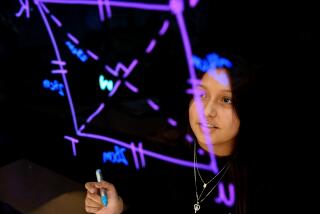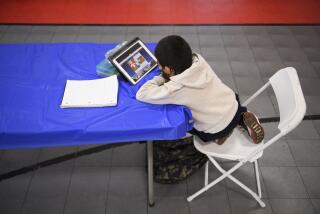‘High-Tech Barn-Raising’ Shows Disparity of Schools
With the click of a mouse, Allison, 7, fires up a video conference with a marine biologist in San Diego. Philip, 9, shoots e-mail to a poet he’s never met, while Molly, 11, pastes eyebrows to the genetic model she built with a program her teacher found on the Internet.
The demonstration of online wonders in the classroom at Seeds University Elementary School in Westwood on Tuesday was part of a campaign to drum up volunteers for NetDay, an ambitious “high-tech barn-raising” aimed at wiring the state’s 13,000 schools to the Internet this Saturday.
Inspired by President Clinton and Vice President Al Gore, who came to California in September and called for public-private cooperation to bring schools into the information age, NetDay’s organizers have rounded up nearly 14,000 volunteers so far. Clinton and Gore plan to revisit the Bay Area this weekend, stopping at a Concord high school to help celebrate the day.
But across town from Seeds, at Esperanza Elementary near MacArthur Park, no one is planning to show up.
While Seeds has one computer for every five students, Esperanza has one for every 30. Only one of Esperanza’s personal computers has a modem, and it takes it about 1,000 times longer to transmit information than Seeds’ direct Internet connection.
“We’d like to participate,” says Esperanza Principal Rowena Lagrosa. “But we don’t have a sponsor and we don’t have the manpower. It’s really a sad state of affairs.”
NetDay’s organizers--like many technology fans--believe the Internet can help to close the gap between the affluent and the less-privileged, especially among the young. In an age in which information increasingly equals power, they argue, the Internet makes it easier and cheaper to get that information than any medium that has come before it.
“If what separates one school from another is its ability to afford things, then access to the Internet starts to level things out,” says Michael Kaufman, director of information technology at the KQED public television station in San Francisco.
But some observers fear that the push to raise the level of technology in schools could have the opposite effect, helping to create a technology underclass that would be even more disadvantaged. With well-intentioned NetDay volunteers flocking mostly to the schools that are already relatively well-equipped, it could be a classic case of the rich getting richer.
“Unless some entity steps in, this could be an accentuator of differences rather than a leveler,” said Leonard Kleinrock, one of the Internet’s inventors and a professor of computer science at UCLA. “[The Seeds school] is a good example of what the Net can offer, but it’s a distorted example.”
Few are eager to be too critical of NetDay. It is, after all, the first broad-based effort of its kind, one that signals a new form of activism and a recognition of the possible benefits that technology could have for millions of California children.
Kaufman and John Gage, chief scientist at the Mountain View-based computer maker Sun Microsystems, have spent the last several months attending school board meetings and lobbying corporations throughout the state to donate labor and equipment for NetDay.
More than 2,500 wiring kits have been donated, each containing enough wire and other hardware to hook up five classrooms and the library at an average school. MCI has donated free Internet accounts to each school. That should help compensate for California’s weak efforts in getting computers into schools: The state has about 14 students per computer, ranking 45th in the nation.
And the project has the strong support of Clinton, who last month announced a national mission to make all children “technologically literate” and proposed a $2-billion program to help accomplish that goal.
A recent U.S. Department of Education study found that while the number of schools that have Internet access has risen to 50%, only 31% of schools with primarily lower-income students have access to the network, while 62% of those whose students are mainly from affluent families are already hooked up.
That technological disparity among schools is mirrored on NetDay’s color-coded electronic map, which shows a red dot for each school that has no sponsors or volunteers, and a green dot for those that do. In Los Angeles, the areas with the highest proportion of red dots are the city’s south and east sides, while areas such as Santa Monica and other parts of the Westside are densely filled with green.
Castle Heights Elementary in Cheviot Hills, for example, has 18 volunteers listed, including a sponsor--”Friends of Castle Heights”--that is planning to pay for the wiring of the school. And while NetDay’s goal is to wire five classrooms in each school, Castle Heights plans to hook up all 18 rooms, with a super-fast ISDN line.
The school has a dedicated computer teacher, and Dave Whitby, a parent who works as an Internet consultant, comes in on Friday afternoons to do Internet workshops for teachers and students. Jane Wishon, president of the PTA, said many of the school’s 80 computers were donated by parents.
“We have five computers in our house, and when we upgraded last year, we brought in our old ones,” said Wishon, who stumbled onto the NetDay site on her home PC. Her husband, a partner at Price Waterhouse, also secured a donation of 15 computers from his firm.
Roberto Correa, a math and science teacher at Huntington Park High School, found out about the project by chance through his brother, a Pacific Bell engineer. Correa has been trying to scrape together the funds to wire several classrooms. He estimates it would cost nearly $300,000, almost one-third in labor costs, and he had hoped NetDay would speed the process along. But no sponsor has come forward.
Because NetDay was organized almost solely over the Internet’s World Wide Web, schools and parents with no access to the network were unlikely to hear about it. Each school in the state has a separate listing where volunteers can sign up. A kit to wire five classrooms, which can be ordered over the Net, costs about $350.
“Where are those sponsors who can donate the routers or cables that are necessary for us to network Huntington Park High School, network within our cluster, network so we can talk to the rest of the world?” asks Correa. “The people who know about this stuff are not the people in our community. We don’t have companies here. Maybe the sponsors don’t know Huntington Park exists.”
Still, Correa has rounded up two alumni to chip in and string cable Saturday. In Compton, several principals contacted by The Times said they had not heard of NetDay, and on the Internet, no Compton schools have sponsors.
The more rural areas of California such as Monterey and Siskiyou counties are also heavily sprinkled with red. John Cradler, legislation policy advisor for WestEd, a regional education research laboratory, says the NetDay effort should be applauded, but it will take more than volunteers to wire the state.
“To me NetDay is a two-sided coin,” says Cradler. “We need to reward the efforts of the White House to support improving the conditions of the schools, but we need to make them see that it needs to be done better next time.”
Gage, who continues to be a tireless evangelist for the cause, says he’s aware of the disparity. He wishes there were more volunteers. And he wishes the state’s corporations had been more generous, both in donations of cash and equipment and in encouraging their employees to go out and help.
But, says Gage, every little bit helps.
“Yes, it’s uneven,” he says. “There are all red dots throughout Compton. But life is uneven. Our point is to show that unevenness and then deal with it. There’s no such thing as NetDay stopping. This is just the beginning.”
NetDay’s Web page is at https://www.netday96.com. The project’s toll-free number is 800-55NET96.
More to Read
Sign up for Essential California
The most important California stories and recommendations in your inbox every morning.
You may occasionally receive promotional content from the Los Angeles Times.









